Crosslee G447S.FERRONAMK2 User manual
- Category
- Fireplaces
- Type
- User manual
This manual is also suitable for
Crosslee G447S.FERRONAMK2 is a decorative gas fire designed to fit into a conventional fire surround and fireplace. It can be used on Natural Gas only.
Some of its features are:
- Decorative fuel effect appliance
- Designed and manufactured to the requirements of the British Standards Institution BS 5258 Part 12: 1990
- Naked flame, a fireguard to British Standard BS 6539 or BS 6778 should be used for the protection of young children, the elderly and the infirm
- A flame supervision device (FSD) is fitted to ensure that should the oxy-pilot extinguish for any reason, (including turning off the appliance) the gas supply to the burner is cut off until the full lighting sequence is repeated.
Crosslee G447S.FERRONAMK2 is a decorative gas fire designed to fit into a conventional fire surround and fireplace. It can be used on Natural Gas only.
Some of its features are:
- Decorative fuel effect appliance
- Designed and manufactured to the requirements of the British Standards Institution BS 5258 Part 12: 1990
- Naked flame, a fireguard to British Standard BS 6539 or BS 6778 should be used for the protection of young children, the elderly and the infirm
- A flame supervision device (FSD) is fitted to ensure that should the oxy-pilot extinguish for any reason, (including turning off the appliance) the gas supply to the burner is cut off until the full lighting sequence is repeated.

82529
Issue 2
SUPER FERRONA 16 MKII
USERS (Pages 2-3)/ INSTALLATION (Pages 4-6)
AND SERVICING INSTRUCTIONS
THIS CAT I
2H APPLIANCE IS FOR USE
ON NATURAL GAS G20 AT A SUPPLY
PRESSURE OF 20mbar IN GB and IE
HAND THESE INSTRUCTIONS TO THE USER

DESCRIPTION
The Super Ferrona 16 MKII is a decorative gas fire designed to fit into a conventional fire surround and fireplace. It
should be fitted to a flue that conforms to a conventional Class I flue (i.e. a brick built chimney of 227 x 227mm
(9x9ins) or 175mm (7ins) diameter lined or stone chimney with the fire back and fireplace components complying
to BS1251. The appliance has a single aerated burner, the design of which produces two parallel ribbons of flame
which run across the front of the fire bed, the rear ribbon of flame is ignited first and the front cross lights from it. A
single control selects ignition (pilot only) and can be turned anticlockwise to select a high rate and then a reduced
rate at maximum rotation. For extra safety, the tap is designed so that the gas cannot be allowed to reach the burner
until the pilot is proven. A separate push button piezo igniter provides pilot ignition.
A flame supervision device (FSD) is fitted to ensure that should the oxy-pilot extinguish for any reason, (including
turning off the appliance) the gas supply to the burner is cut off until the full lighting sequence is repeated. The oxy-
pilot or O.D.S. will cause the appliance to ‘shut off’ in the event of continued spillage occurring under hazardous or
blocked flue conditions.
The unit is secured to the hearth with two fixing screws to prevent stress on the gas inlet connection.
Two types of fire fronts and frets are recommended, as shown on page 8, they have perforated frets to allow air to be
drawn into the coal bed for combustion and over the controls for cooling purposes. If other fronts and frets are to be
used they must have a minimum open area in the fret of 20 square centimetres and 60 square centimetres in the
front. See Fig 10.
A decorative brass trim is available as an optional extra to locate on the inner edges of the fireplace/surround
opening, the trim has 50mm deep flanges to assist with fixing the trim in position.
IMPORTANT NOTES
The Super Ferrona 16 MKII is a decorative fuel effect appliance designed and manufactured to the requirements of
the British Standards Institution BS 5258 Part 12: 1990 and is for use on Natural Gas only.
All gas appliance installations must be installed by a competent person in accordance with the current Gas Safety
(Installation and Use) Regulations 1994 (as amended) or the rules in force and in accordance with the attached
Installation Instructions, failure to do so could lead to prosecution.
The chimney flue (unless new) must be swept prior to installation. It should be checked annually for spillage (smoke
test) when the appliance is serviced and that there is no excessive build up of soot.
The appliance has a naked flame, a fireguard to British Standard BS 6539 or BS 6778 should be used for the
protection of your young children, the elderly and the infirm. Combustible materials should not be put on or left in
the hearth, nor should the coal bed be used to burn rubbish or other materials.
Care must be taken on the selection of wall coverings within close proximity of the fire as some vinyl and embossed
materials may become discoloured by convected heat. Soft furnishings must be kept clear from the radiant heat of
the fire and from impinging the hearth area. The hearth must not be covered by any combustible materials such as
carpet etc.
It is recommended that the appliance is serviced annually by a competent person and the flue checked for
satisfactory clearance of products and that there is no excessive build up of soot.
The curing effect of heating the coals will cause an initial odour which, although not harmful, may require
additional ventilation until the odour has disappeared. This appliance will run on Full for approximately 4.4 hours
on one therm of gas.
This product uses fuel effect pieces, gaskets and insulation material containing Refractory Ceramic Fibre (RCF),
which are man-made vitreous silicate fibres. Excessive exposure to these materials may cause temporary irritation to
eyes, skin and respiratory tract, consequently, it makes sense to take care when handling these articles to ensure that
the release of dust is kept to a minimum
Page 2

TO LIGHT THE APPLIANCE
1. Remove the fret (controls cover).
2. Press and turn the gas control until the indicator mark is opposite to IGN. Keep the control fully depressed.
Press and release the ignition button. Check that the pilot flame has lit at all ports. Keep the gas control
depressed for a further 20 seconds. Release the gas control and check the pilot remains alight.
3. Depress the gas control slightly and turn fully anticlockwise until the indicator mark is opposite the small flame
symbol. The burner will now ignite from the pilot assembly and run at the low rate.
4. Depress the gas control slightly and turn clockwise until the indicator mark is opposite to the large flame
symbol. The burner will now run at its maximum rate.
5. To turn the appliance ‘off’, return the control to the ‘off’ position.
6. If for any reason the fire cuts out, return the control knob to the `off’ position and wait 3 minutes before re-
lighting.
REMOVAL OF DEBRIS or SOOT DEPOSIT
Allow the appliance to cool for two to three hours before removing all of the coals and ceramic blocks for cleaning
purposes. Once all the ceramics are removed from the fire bed check that no debris is located in the burner slots
(both front & rear). If any debris is present it may easily be removed by using a small piece of thin cardboard to
ease out any foreign matter. Be sure to remove the cardboard after use. Cleaning should be carried out in a well-
ventilated area or in the open air, by gently brushing with the pieces held away from your face so that you avoid
inhaling the dust. We do not recommend the use of a normal domestic vacuum cleaner, which may blow dust back
into the air.
SETTING UP THE COAL BED. (See the identification sheet on page 8)
Components
2 burner inserts. 16 Large Coals.
Coal support shelves (L&R hand). 4 Medium Coals.
Artificial coal front. 2 Triangular Coals
Place the left and right coal support shelves with the rebate on the underside, over the rear flange of the support
channel. Place the two Tee shaped burner inserts into the channel between the front and rear ports of burner. Locate
the fibre artificial coal front on the shelf above the fascia panel. Figures 4 & 5.
COAL LAYOUT
First Layer. Position 3 large coals with their rear edge on the burner inserts. Place 4 coals at the rear of the coal
support shelf and lay 5 more across as a middle row. See fig. 6. Two triangular coals are placed one either side of
the front row ensuring that the one on the right does not lay on the pilot assembly.
Second Layer. Position the remaining 4 large with the 4 medium coals in the positions shown in fig.7.
To obtain the best visual appearance it may be necessary to make slight adjustments to the position of the coals.
NOTE: Additional coals must not be used. If any of the coals or the coal bed becomes damaged, lost or broken,
replacements must be obtained before the appliance is used.
VENTILATION
Purpose built ventilation is not required for this appliance in GB only. For Ireland (IE) ventilation is required with a
minimal cross sectional area of 100 sq. cms and should be checked regularly to ensure that it is free from
obstruction. It must be fitted in accordance with the rules in force.
CLEARANCE TO SHELVES
Minimum clearances to underside of a 150mm (6ins) combustible shelf from the top of the fire opening must be
228mm (9ins). Add 12.5mm (1/2in) to this clearance for every 25mm (1in) increased depth of shelf.
CLEARANCE TO SIDES
Minimum Clearance required to any combustible material to the side of the appliance must be 150mm (6in)

Page 3
THE FOLLOWING SECTION LISTS THE INSTALLATION REQUIREMENTS AND REGULATIONS
The relevant Codes of Practice and British Standards are: -
BS 5440 Part 1 1990 The Building Regulations issued
BS 5440 Part 2 1989 by the Department of the Environment.
BS 6461 Part 1 1984
BS 5871 Part 3 1991 The Building Standards (Scotland)
BS 6891 1988 (Consolidation) Regulations issued
BS 8303 1994 by the Scottish Development Department.
BS 1251 1987
In particular: -
The fireplace and chimney or flue must comply with the requirements of BS 8303 1986 & BS6461 Part 1 1984.
The effective flue height must be a minimum of 3 metres and should be of 225mm x 225mm brick, stone or a lined
chimney with a minimum diameter of 175mm.
Any permanent flue restriction must be removed and any variable dampers locked fully open or removed. The
chimney flue must be swept prior to installation unless new and the gas installation must use rigid or semi-rigid
tube.
A non-combustible hearth with a minimum thickness of 12.5mm and having a perimeter of 50mm above floor level
is required to discourage placing carpets or combustible materials close to the hearth. The width must be a minimum
of 150mm either side of the fireplace opening and a depth of 300mm from the front face of the opening.
Purpose built superimposed fire resisting hearths and back panels, specified as suitable by the manufacturer may be
used. If hearths or back panels are not suitable for solid fuel, they should have been clearly marked, ‘Not suitable for
solid fuels.’
TECHNICAL DATA
Height 295mm Type of Gas G20 (NG) only
Width 350mm Max Heat Input (Gross) 6.6kW - 22520 Btu/h
Depth 260mm Min Heat Input (Gross) 3.83kW -13070 Btu/h
Overall depth Supply Setting pressure 20mbar +/- 1mbar (cold)
(Mach II) inc. F&F 310mm
(JB) 330mm
See fig 2. for the sizes of fireplace opening
Injector Stereomatic 046.19.196.076
Or Bray Cat 82/460
Gas valve Isphording GH379 001 003 00A
Or Thermaco 21018B
Pilot Assembly SIT Oxy-pilot assembly NG9022
Or Concentric ODS1
Note. None of the materials used in the manufacture of this appliance contain asbestos.
INSTALLING THE APPLIANCE
When an existing refractory fire back (chairbrick) is fitted, care must be taken to ensure that the depth of the
opening is no less than 205mm from the front face of the surround to the front face of the chairbrick. This is to
ensure that no luminous flame extends beyond the front face of the opening. See fig. 2.

Page 4
Site the appliance as far back as possible whilst maintaining a central position in the opening, establish where the
fixing holes are to be. A bracket is supplied in the fixing kit; this can be located either to the front or to the rear of
the fascia panel. To the rear the fixing holes will probably coincide with a concrete base within the opening which
will prevent drilling into a marble hearth etc, access to these two holes would be through two of the large holes
above the fascia panel. Alternatively the bracket can be reversed to allow access to the front of the fascia panel see
fig. 3. Having decided the preferred position, mark and drill suitable holes for the fixing plugs and screws provided
and screw the appliance in position.
CONNECTING THE GAS SUPPLY
Determine where the gas supply is to be connected to the appliance. This may be made from the front of the unit
from either the left or right side or, a concealed fitting from the rear of the inlet elbow.
TURN OFF ANY APPLIANCES THAT ARE FED BY THE METER AND ISOLATE THE GAS SUPPLY
BY TURNING OFF AT THE METER.
If the supply is to be a concealed connection it would be advisable to route the supply to the left side of the unit
taking into account the requirements of BS 6891:1988 dealing with enclosed pipes. This standard requires that when
a gas pipe is fed through a wall, it should be enclosed in a gas tight sleeve to protect against failure caused by
movement and shall be constructed to prevent passage of gas either between the pipe and sleeve or sleeve and wall.
Connections may be made from the front of the appliance from either the left or right in 8 mm diameter pipe, if a
right hand connection is required the tube should be routed across the front of the fascia panel by rotating the inlet
elbow to the required position. See fig 4. A suitable isolating cock or restrictor elbow should be fitted close to the
appliance to facilitate servicing.
TO CHECK THE APPLIANCE SETTING PRESSURE.
The pressure test point at the inlet elbow enables verification of the inlet pressure at the appliance under operating
conditions and can also be used to check the gas soundness of the connections to the appliance gas control.
SETTING UP THE COAL BED. (See the identification sheet on page 8)
Components
2 burner inserts. 16 Large Coals.
Coal support shelves (L&R hand). 4 Medium Coals.
Artificial coal front. 2 Triangular Coals
Place the left and right coal support shelves with the rebate on the underside, over the rear flange of the support
channel. Place the two Tee shaped burner inserts into the channel between the front and rear ports of burner. Locate
the fibre artificial coal front on the shelf above the fascia panel. Figures 4 & 5.
Note. If any of the coals or the coal bed becomes damaged, lost or broken, replacements must be obtained before
the appliance is used.
COAL LAYOUT
First Layer. Position 3 large coals with their rear edge on the burner inserts. Place 4 coals at the rear of the coal
support shelf and lay 5 more across as a middle row. See fig. 6. Two triangular coals are placed one either side of
the front row ensuring that the one on the right does not lay on the pilot assembly.
Second Layer. Position the remaining 4 large with the 4 medium coals in the positions shown in fig.7.
To obtain the best visual appearance it may be necessary to make slight adjustments to the position of the coals.
NOTE: Additional coals must not be used
Page 5

TO LIGHT THE APPLIANCE AND CHECK THE CORRECT OPERATION
1. Remove the fret (controls cover).
2. Press and turn the gas control until the indicator mark is opposite to IGN. Keep the control fully depressed.
3. After a suitable interval to ensure that the pipes are purged of air, press and release the ignition button. Check
that the pilot flame has lit at all ports. Keep the gas control depressed for a further 20 seconds.
4. Release the gas control and check the pilot remains alight.
5. Depress the gas control slightly and turn fully anticlockwise until the indicator mark is opposite the small flame
symbol. The burner will now ignite from the pilot assembly and run at the low rate.
6. Depress the gas control slightly and turn clockwise with the indicator mark opposite to the large flame symbol.
The burner will now run at its maximum rate.
7. Turn the gas control to the OFF position, wait for 90 seconds, fully depress the gas control, turn to IGN position
and release the control. Attempt to light the pilot with an already prepared match or taper. If the pilot lights the
FSD is faulty.
8. Light the appliance and set to the large flame position, locate the front and fret in position and leave to warm up
for 5 minutes. Check for satisfactory clearance of combustion products by inserting a lighted smoke match into
the opening in the position shown in Fig.9, i.e. 100mm below the top of the opening and 10mm behind the front
face. All the smoke must be clearly drawn into the flue. If this does not occur, allow a further 10 minutes and
repeat the test. Should spillage still occur, examine the chimney for the fault and rectify. The test should be
repeated if an extractor fan or fan powered flue appliance is fitted to the room. If there is a connected room with
an extractor fan, the test should be repeated with all the connecting doors to that room opened.
Demonstrate the lighting and extinguishing procedures.
ADVISE THAT:
The curing effect of heating the coals will cause an initial odour, these are not harmful although additional
ventilation (e.g. opened window) may be required.
Advise the customer that they should read their Users Instructions before operating the fire and always follow the
advice in the section headed ‘Removal of Debris or Soot Deposits’.
The appliance is fitted with an Oxy-pilot to prevent the continued operation in the event of spillage occurring. If the
fire shuts ‘OFF’ repeatedly the appliance must be turned off and not used until an expert is consulted.
When any debris or soot is to be cleaned from the appliance a vacuum cleaner may be used carefully. The appliance
must be serviced annually by a competent person in accordance with these instructions and the appliance checked
for spillage in accordance with the method detailed in these instructions.
Complete the section in the enclosed registration leaflet. Advise that any component part of this appliance be
guaranteed against defective workmanship or faulty materials for a period of twelve months from the date of
purchase.
Any such part will be replaced free of charge on receipt of the purchasers address at the cost of postage only,
provided that:
a) It is accompanied by the registration section cut out of the booklet together with the original purchase receipt,
which will be returned with the replacement part.
b) A competent person has carried out installation repairs or adjustments, such as the supplier’s representative or a
CORGI registered installer.

Page 6
MAINTENANCE AND SERVICING
GENERAL
A. REMOVAL OF DEBRIS or SOOT DEPOSIT
Allow the appliance to cool for two to three hours before removing all of the coals and ceramic blocks for cleaning
purposes. Once all the ceramics are removed from the fire bed check that no debris is located in the burner slots
(both front & rear). If any debris is present it may easily be removed by using a small piece of thin cardboard to
ease out any foreign matter. Be sure to remove the cardboard after use. To ensure that the release of fibres from
these RCF articles is kept to a minimum, during installation and servicing we recommend that you use a HEPA
filtered vacuum to remove any dust and soot accumulated in and around the fire before and after working on the fire.
When replacing these articles we recommend that the replaced items are not broken up, but are sealed within heavy
duty polythene bags, clearly labelled as RCF waste. This is not classified as "hazardous waste" and may be disposed
of at a tipping site licensed for the disposal of industrial waste. Protective clothing is not required when handling
these articles, but we recommend you follow the normal hygiene rules of not smoking, eating or drinking in the
work area and always wash your hands before eating or drinking. Any sooty deposit on the thermocouple probe can
be cleaned off using a non-fluffy cloth.
* DO NOT USE ABRASIVE MATERIALS *
B. SERVICING COMPONENTS BELOW THE BURNER ASSEMBLY
Remove coals, coal supports, burner inserts and front simulated coal. To gain access to components below the
burner assembly it has to be removed from the case by disconnecting the gas supply at the inlet elbow and
unscrewing the two screws at the base of the fascia panel. Where the supply is fed from the right hand side across
the front of the fire, it will be necessary to disconnect the supply from the isolation tap/elbow.
i) TO CLEAN OR REPLACE THE INJECTOR: Unscrew the compression nut connecting the gas supply to the
elbow injector while supporting the injector. This is to prevent distortion of the framework, unscrew and remove the
gas supply tube from the gas control valve, hold the injector lock nut with a spanner and rotate the injector. Replace
in reverse order.
ii) TO REPLACE THE GAS CONTROL VALVE: Disconnect the three gas pipes and the thermocouple from the
control. Pull off the knob and lay to one side. Undo the retaining nut at the front of the tap niting position to
withdraw the control from the mounting bracket. Replace in reverse order.
iii) TO REPLACE THE PIEZO IGNITER: Pull off the HT lead from the rear of the igniter. Retain the metal fixing
nut with one finger and rotate the body of the igniter to unscrew. Withdraw the igniter from the front. Replace in
reverse order and reconnect the HT lead.
iv) TO CLEAN OR REPLACE THE OXY-PILOT ASSEMBLY (including electrode and thermocouple): Unscrew
the self -tap screw securing the clamp bracket. Undo the supply tube nut at the gas connection to the pilot; withdraw
the Oxy-pilot assembly. Clean off any lint or fluff taking care to avoid damage. The individual parts cannot be
changed separately as the assembly is precision built. Reassemble in reverse order. It is advisable to check joints for
leaks prior to refitting the burner unit into position.

Page 7
SHORT PARTS LIST
For spares contact the manufacturer at the address overleaf.
DESCRIPTION CROSSLEE No GC No
Piezo Igniter 40245 397 686
Control Knob 40232 170 014
Control Valve 41833 386 147
Oxy-Pilot Burner Assembly (SIT) 42313
Main Injector Bray Cat 82/460 41669 379 871
Or (Stereomatic) 41670
Coal Support Shelf 42889
Front Coal mould 40481 170 248
Set of Coals 42893

Page 8

Page 9

Page 10

Page 11

MAX HEAT INPUT (GROSS)
6.6 kW 22450 Btu/hr
Royal Cozyfires are manufactured by:
CROSSLEE plc
Aber Park Industrial Estate,
Aber Road, Flint, Flintshire. CH6 5EX
Spares Tel 01422 203963
Fax: 01422 204475
Service (GSA Ltd) 01703 516611
Customer Service 01422 200660
Fax 01422 206304
*Technical Help Line 0906 8633268
*Calls charged at 60p per minute
-
 1
1
-
 2
2
-
 3
3
-
 4
4
-
 5
5
-
 6
6
-
 7
7
-
 8
8
-
 9
9
-
 10
10
-
 11
11
-
 12
12
-
 13
13
Crosslee G447S.FERRONAMK2 User manual
- Category
- Fireplaces
- Type
- User manual
- This manual is also suitable for
Crosslee G447S.FERRONAMK2 is a decorative gas fire designed to fit into a conventional fire surround and fireplace. It can be used on Natural Gas only.
Some of its features are:
- Decorative fuel effect appliance
- Designed and manufactured to the requirements of the British Standards Institution BS 5258 Part 12: 1990
- Naked flame, a fireguard to British Standard BS 6539 or BS 6778 should be used for the protection of young children, the elderly and the infirm
- A flame supervision device (FSD) is fitted to ensure that should the oxy-pilot extinguish for any reason, (including turning off the appliance) the gas supply to the burner is cut off until the full lighting sequence is repeated.
Ask a question and I''ll find the answer in the document
Finding information in a document is now easier with AI
Related papers
-
Crosslee G448S.FERRONA18 User manual
-
Crosslee G406S.HOTTOASTER User manual
-
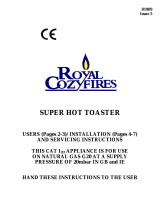 Royal Consumer Information Products G405S.HOTTOAST.MK2 User manual
Royal Consumer Information Products G405S.HOTTOAST.MK2 User manual
-
Crosslee G449ELITEMKII User manual
-
Crosslee G450CLAREMONT User manual
-
Crosslee G477S.LINESTD User manual
-
Crosslee G401SSUPER16NV User manual
-
Royal Consumer Information Products Super Sixteen NV Decorative Gas Fireplace User manual
-
Crosslee G507S.HOTTOASTER User manual
-
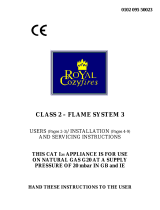 Royal Consumer Information Products Gas Fire User manual
Royal Consumer Information Products Gas Fire User manual
Other documents
-
 Royal Consumer Information Products Super Hot Toater User manual
Royal Consumer Information Products Super Hot Toater User manual
-
AEG G20 User manual
-
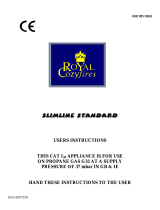 Royal Consumer Information Products G31 User manual
Royal Consumer Information Products G31 User manual
-
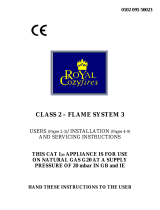 Royal Consumer Information Products Gas Fire User manual
Royal Consumer Information Products Gas Fire User manual
-
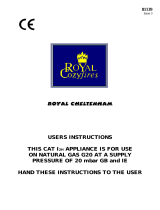 Royal Consumer Information Products U19019 G20 User manual
Royal Consumer Information Products U19019 G20 User manual
-
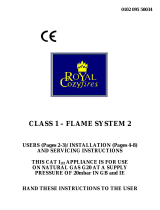 Royal Consumer Information Products Fire Pit G20 User manual
Royal Consumer Information Products Fire Pit G20 User manual
-
Royal Consumer Information Products Super Sixteen NV Decorative Gas Fireplace User manual
-
Flavel Diamond HE Installation, Maintenance & User Instructions
-
Flavel Caress HE FHEC**MP Installation, Maintenance & User Instructions
-
Flavel Caress HE FHEC**MP Installation, Maintenance & User Instructions



















